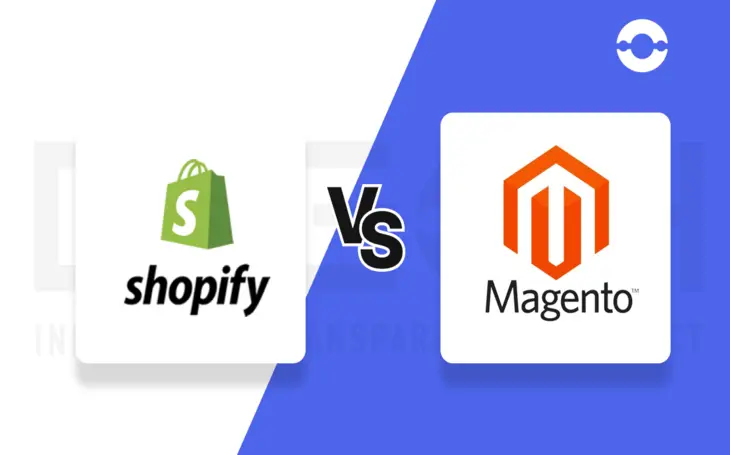
While a lot of businesses want to enter the e-commerce world, they are often in a fix about which e-commerce platform to choose. As a result, ‘Shopify vs Magento’ often tops the list of dilemmas.
Therefore, in this blog, we have briefly listed the features and pros and cons of the two e-commerce platforms. Furthermore, we have differentiated between Shopify and Magento (now Adobe Commerce) to help businesses choose the platform that caters to their needs and fit their budgets.
What is e-Commerce?
E-commerce is electronic commerce that refers to the sale and purchase of goods and services online. It has taken over the retail and shopping world. For this reason, a business that lacks an e-commerce website is losing out on sales, and revenue. Additionally, it is playing below its full potential.

An eMarketer study stated that despite the slow growth after the pandemic, total e-commerce spending will exceed $7 trillion by 2025.
Giants like Amazon and Alibaba are achieving heights through their e-commerce websites. But how? Why is e-commerce gaining so much popularity?
E-commerce app is helping businesses to gain access to a wider audience and also diversify to distant markets. It further provides relatively cheaper and more efficient distribution channels for products or services offered by a business. This leads to increased business visibility, sales, and hence, revenue, with lower start-up costs.
Moreover, amidst such uncertain times when natural disasters are striking different parts of the world, a pandemic has taken over and other domestic issues, e-commerce seems to be the best bet for businesses.
Walmart recorded an increase of 97% in sales in 2020. In the second quarter of the same year, e-commerce giant, Amazon’s sales and profit also grew by 40%.
Customers could sit at their homes, buy goods, and avail of services as and when required with just a few clicks.
E-commerce is especially beneficial for small businesses. It helps them enter the market without huge start-up costs and also keeps them running. Through different types of e-commerce platforms, small businesses can build their websites and reach more customers, which otherwise is a challenge due to a lack of resources.
But what are these platforms that facilitate the creation of e-commerce websites?
E-commerce platforms facilitate the trade of goods and services on the Internet.
Three Key e-Commerce Platforms:
1. Open Source:
These platforms have cloud or on-premises as their hosting environment. However, they allow manual modification of the code. Furthermore, patches and platform updates require manual implementation across the board.
2. SaaS (software-as-a-service) and PaaS (platform-as-a-service) platforms:
SaaS platforms are hosted on the cloud and subscription-based solutions. It is built and maintained by a third-party provider so users just buy it on rent, without having to build and develop the platform.
On the other hand, PaaS platforms are just an extension of SaaS platforms. When the latter comes with hardware elements as well, it is called a PaaS platform.
3. Headless commerce platforms:
This is a version of CaaS e-commerce wherein the shopping cart is decoupled from the CMS.
While all the above platforms have their use cases, open-source platforms are deemed cumbersome, expensive to maintain in the long run and ones that require in-depth technical knowledge. The responsibility of security, compliance, and maintenance is on the user and hence with open-source platforms, there is a higher cost of ownership.
SaaS and PaaS, on the other hand, are considered more maintainable and cost-effective options. They further help businesses to get to the market relatively faster.
These options are especially better for smaller businesses or companies that are new entrants into the e-commerce environment. Initial professional setup and support, are provided to users with monthly fees for the usage of the site, in addition to transaction costs for every purchase made. These platforms are further scalable, as per business requirements.
However, let’s look at the two most popular e-commerce platforms, Shopify (SaaS platform) and Magento (Open-source platform), differentiate between them, and look at their use cases. This would help businesses to choose which one fits better for their needs.
Shopify and Magento: E-commerce Platforms
While Shopify is a SaaS platform, Magento is an open-source e-commerce platform. Both these platforms are popular for e-commerce website development and are commonly used by businesses across the globe.
These eCommerce website builder platforms are easy to use and are also scalable. They target different business needs, and additionally, differ in terms of features, functionalities, and costs.
To begin with, let’s understand Shopify and Magento briefly and then jump to the question of Shopify vs Magento for e-commerce website development.
Shopify

Shopify is a SaaS e-commerce platform. It offers monthly plans for website building that cater to different budgets.
This platform handles PCI compliance and security and also offers solid uptime stats. Easy to use, it has mobile-friendly designs and a checkout that can be customized.
Pros of Shopify:
- Offers both physical and digital products
- Multiple integrated apps are offered for additional features and functionalities
- Offers unrestricted bandwidth and also storage
- Allows users to track and also manage inventory
- Offers around-the-clock customer support
- Accepts recurring payments for the subscriptions made on the website
- Offers mobile apps and is also SEO-friendly
Cons of Shopify:
- Costs can add up for the site in case additional features and functionalities are opted for, such as premium themes and linking to other apps
- Rigid API call per second limits
- Customization offered for product and content pages is limited
- The modest learning curve for first-timers
- Blogging features could use some improvements
- Lacks scalability, with a built-in 3-option limit per product
For more: The Ultimate Guide To Shopify Theme Development
Magento (Adobe Commerce)

Adobe Commerce, formerly known as Magento, offers real-time inventory control, SEO- friendly features, automated tools for marketing as well as multi-store functionality.
This platform requires businesses to have their own designers and developers as well as undertake their own maintenance and support of the website. This makes calculating the total cost of ownership a challenging task.
Pros of Magento:
- Pre-built integrations with Adobe software
- Offers advanced personalization
- Makes use of AI to personalize a user’s experience
- Provides shopper analysis
- Offers multiple extensions in its marketplace, ranging from $0 to $15,000
- Supports Progressive Web Applications (PWAs)
Cons of Magento:
- Does not offer automatic features and version updates
- Lacks native theme editor
- The complete builds could involve higher costs due to extensive setup requirements
- Cases of security breaches and also vulnerabilities have been reported in the past
- Not as suitable for small businesses
- Lacks pricing transparency
Now that we have a basic understanding of these two platforms, let’s look at the differences between Shopify and Magento in the blog ahead.
Shopify vs Magento
The key differences between Shopify and Magento are as follows:
| Features | Shopify | Magento (Adobe Commerce) |
| Type of E-commerce | SaaS e-commerce platform | Open-source e-commerce platform |
| Pricing | Monthly subscription fees | Free, open-source platform. Only involves the cost of in-house web developers |
| Themes Options | Multiple options available. The choice should be made as per use case and design preference. | Limited options are available. The options available are customizable. Themes can be built from scratch as well. |
| Customization | Difficult and limited | Full customization available |
| Operating Cost | Very high | Medium |
| Ease of Use | Relatively easier to use; a low learning curve Offers drag-and-drop editor; suitable for beginners | Relatively difficult to use; a steeper learning curve Requires interpretation of jargon and coding skills |
| Type of users | Technical as well as non-technical users | Technical users/ Developers |
| Suitability | Large companies with big budgets | Any sized company with technical know-how |
| Restful API | GraphQL (Throttling limit usage) | Rest API (Unlimited usage) |
| On-Premise | No (Only on Cloud) | Yes (Cloud option also available) |
| App | Customization possible through APIs | Customization possible |
| SEO Friendly | Best for SEO; built-in tools and SEO extensions | SEO friendliness depends upon the quality of the code. Backend UI code should be written well keeping SEO in mind. |
| Security | SSL Certificate and PCI-DSS compliant | The owner is responsible for all security-related certificates |
Shopify vs Magento: Which One Should You Choose?
While both the e-commerce platforms offer extensive benefits and serve the purpose efficiently, they have their use cases that make the choice a bit easier for businesses. A major part of the Shopify vs Magento debate depends upon the use cases.
Shopify is most suitable for omnichannel sellers, as well as sellers who want a user-friendly way of building a dropshipping business. It additionally offers multiple dropshipping integrations.

Magento or Adobe Commerce should be opted for by businesses that require an enterprise-level platform that offers robust personalization features. This platform uses Adobe Sensei, its AI technology, to give its shoppers personalized recommendations in order to enhance their experience.
Parting Words…
While Shopify is an expensive affair but manages everything efficiently, from security to compliance, Magento is a cheaper option, however, it requires businesses to have the technical knowledge and know-how to create an e-commerce website.
Both options are equally good. Therefore, a business should choose according to its requirements and the resources available.
How can we help?
BigOhTech, a leading name in the tech industry has been helping small as well as large businesses, alike, to start their e-commerce journey and increase their customer base, sales, and revenue.
BigOh specializes in Shopify and Magento e-commerce website development and ensures that the client is reaping the benefits of these platforms, cost-effectively.
With agile and highly skilled teams of designers and developers, we build reliable, scalable, and modern e-commerce solutions that are also compatible with emerging technologies.
Jump on the e-commerce bandwagon today with BigOh’s efficient digital solutions!
E-commerce made easy!
Similar Read: WooCommerce Vs Magento For Online Stores
FAQs:
Q1. Shopify vs Magento: which one is better for small businesses?
Small businesses should go for SaaS platforms such as Shopify as the platform is easier to use and enter the market with as it provides them with professional setup and support.
Q2. Can I customize my online store using Shopify or Magento?
Yes, one can customize an online store using Shopify or Magento. The former allows limited customization but is easy to use. The latter allows complete customization but requires in-depth technical skills.
Q3. Which platform is better for beginners, Shopify or Magento?
Shopify is a better option for beginners seeking an e-commerce website. This is because the drag-and-drop editors make the platform easy to use.
Q4. Which platform is better for SEO, Shopify or Magento?
Shopify is a more SEO-friendly platform. In fact, it is the best platform out there for SEO. On the other hand, Magento performs averagely in terms of SEO, or it mostly depends upon the quality and SEO friendliness of the backend code written.




